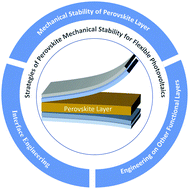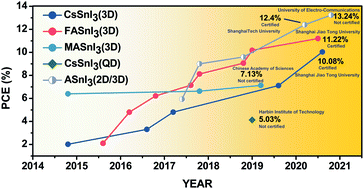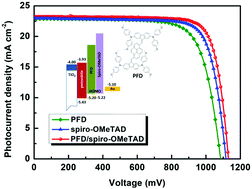Themed collection FOCUS: Recent Progress on Perovskite Solar Cells, 2021-2022

Challenges of lead leakage in perovskite solar cells
This review summarizes the latest research progress on strategies for lead leakage control in perovskite solar cells to facilitate the future development of efficient, stable, and environmentally friendly perovskite photovoltaic devices.

Mater. Chem. Front., 2022,6, 2779-2789
https://doi.org/10.1039/D2QM00632D
Defects and stability of perovskite solar cells: a critical analysis
Metal halide perovskite solar cells (PSCs) continue to improve their power conversion efficiency to over 25.5%, which is at the same level as silicon solar cells.

Mater. Chem. Front., 2022,6, 400-417
https://doi.org/10.1039/D1QM01250A
Strategies of perovskite mechanical stability for flexible photovoltaics
This review summarized the different strategies of enhancing the perovskite mechanical stability, and we mainly describe from three aspects: mechanical stability of perovskite layer, interface engineering and engineering on other functional layers.

Mater. Chem. Front., 2021,5, 7467-7478
https://doi.org/10.1039/D1QM00616A
Metal halide perovskite-based flexible tandem solar cells: next-generation flexible photovoltaic technology
Flexible perovskite-based tandem solar cells could be the game-changer for next-generation flexible photovoltaics.

Mater. Chem. Front., 2021,5, 4833-4850
https://doi.org/10.1039/D1QM00279A
Recent progress of metal-halide perovskite-based tandem solar cells
This review presents critical advances of perovskite-based tandem solar cells (TSCs). Electrode engineering, interface engineering, bandgap engineering, and processing techniques are discussed, as well as the future directions and challenges.

Mater. Chem. Front., 2021,5, 4538-4564
https://doi.org/10.1039/D0QM01085E
Rational strategies toward efficient and stable lead-free tin halide perovskite solar cells
We summarized the recent reported strategies for overcoming the challenges for lead-free tin halide perovskite solar cells (THPSCs), expecting to give a perspective outlining the possible future direction for THPSCs.

Mater. Chem. Front., 2021,5, 4107-4127
https://doi.org/10.1039/D0QM01002B
Research and progress of black metastable phase CsPbI3 solar cells
This review discusses the latest progress in improving the performance and stability of CsPbI3 PSCs based on the metastable phase.

Mater. Chem. Front., 2021,5, 1221-1235
https://doi.org/10.1039/D0QM00756K
Boosting the performance and stability of inverted perovskite solar cells by using a carbolong derivative to modulate the cathode interface
A carbolong derivative with a M-PCCO framework was employed as the cathode interlayer, boosting the performance and stability of inverted PSCs.

Mater. Chem. Front., 2022,6, 2211-2218
https://doi.org/10.1039/D2QM00452F
Enhanced photovoltaic output of bifacial perovskite solar cells via tailoring photoelectric balance in rear window layers with 1T-WS2 nanosheet engineering
A novel organic-inorganic hybrid rear window layer (RWL) was constructed. The photoelectric balance of the hybrid RWL was improved by doping with 1T-phase WS2 (1T-WS2).

Mater. Chem. Front., 2022,6, 2061-2071
https://doi.org/10.1039/D2QM00366J
Controlling the charge carrier dynamics by modulating the orientation diversity of perovskites
Photo-induced charge carrier dynamics over a wide time domain from sub-nanoseconds to microseconds, via time-correlated single photon counting and flash photolysis time-resolved microwave conductivity measurements.

Mater. Chem. Front., 2022,6, 1026-1032
https://doi.org/10.1039/D1QM01586A
Designing a novel Eu2+-doped hafnium-silicate phosphor for an energy-down-shift layer of CsPbI3 solar cells
Novel cyan-green emitting Eu2+ doped K2HfSiO5 phosphors were synthesized and applied in CsPbI3 perovskite solar cells as an energy-down-shift layer.

Mater. Chem. Front., 2022,6, 724-736
https://doi.org/10.1039/D1QM01655E
Rational design of D–π–D hole-transporting materials for efficient perovskite solar cells
D–π–D hole-transporting materials are designed via facile approaches for efficient perovskite solar cells. Suitable band alignment and high hole mobility by strengthening the conjugation in the core allow effective hole extraction.

Mater. Chem. Front., 2021,5, 7824-7832
https://doi.org/10.1039/D1QM01015H
Triethyl phosphate in an antisolvent: a novel approach to fabricate high-efficiency and stable perovskite solar cells under ambient air conditions
In this contribution, PSCs with a high efficiency and good stability are fabricated under ambient conditions without a glove box via introducing triethyl phosphate (TEP) into a perovskite through an antisolvent.

Mater. Chem. Front., 2021,5, 7628-7637
https://doi.org/10.1039/D1QM00680K
Polymeric hole-transporting material with a flexible backbone for constructing thermally stable inverted perovskite solar cells
A type of comparatively flexible binaphthyl-ether structured polymer, which reveals high device thermal-durability, is reported.

Mater. Chem. Front., 2021,5, 7241-7250
https://doi.org/10.1039/D1QM00869B
Pyridyl-functionalized spiro[fluorene–xanthene] as a dopant-free hole-transport material for stable perovskite solar cells
We have developed a novel HTM named SPS-SPX-2TPA for perovskite solar cell applications. This HTM showed the best PCE of 17.39% and maintained 95% of their initial PCE even after 600 h. It is three times cheaper cost than the Spiro-OMeTAD HTM.
![Graphical abstract: Pyridyl-functionalized spiro[fluorene–xanthene] as a dopant-free hole-transport material for stable perovskite solar cells](/en/Image/Get?imageInfo.ImageType=GA&imageInfo.ImageIdentifier.ManuscriptID=D1QM00435B&imageInfo.ImageIdentifier.Year=2021)
Mater. Chem. Front., 2021,5, 7276-7285
https://doi.org/10.1039/D1QM00435B
Graphdiyne oxide doped SnO2 electron transport layer for high performance perovskite solar cells
Graphdiyne oxide-doped SnO2 is applied as a novel electron transfer layer for the preparation of high-performance perovskite devices.

Mater. Chem. Front., 2021,5, 6913-6922
https://doi.org/10.1039/D1QM00592H
Arm modulation of triarylamines to fine-tune the properties of linear D–π–D HTMs for robust higher performance perovskite solar cells
Most organic hole-transport materials (HTMs) toward efficient perovskite solar cells (PSCs) thus far still rely on methoxytriphenylamine, which limits the photovoltage and decrease the stability of PSCs.

Mater. Chem. Front., 2021,5, 4604-4614
https://doi.org/10.1039/D1QM00190F
A new molecular material as a dopant-free hole-transporting layer for stable perovskite solar cells
In this work, a new small molecular material, 9,9′-(pyrene-1,6-diyldimethylylidene)bis[N,N,N′,N′-tetrakis(4-methoxyphenyl)-9H-fluorene-2,7-diamine] (PFD), as a hole-transporting layer was designed for perovskite solar cells (PSCs).

Mater. Chem. Front., 2021,5, 4291-4299
https://doi.org/10.1039/D0QM01051K
Construction and mechanistic understanding of high-performance all-air-processed perovskite solar cells via mixed-cation engineering
This study employs mixed formamidinium/methylammonium (FA/MA) organic cations as an efficient perovskite layer, resulting in a champion PCE of up to 19.50%, one of the highest efficiencies yet reported for ambient air-processed PSCs.

Mater. Chem. Front., 2021,5, 4244-4253
https://doi.org/10.1039/D1QM00149C
Inverted perovskite solar cells based on potassium salt-modified NiOX hole transport layers
Potassium salts modified NiOX could improve the perovskite film coverage and reduce trap densities, so as to improve device performance.

Mater. Chem. Front., 2021,5, 3614-3620
https://doi.org/10.1039/D0QM01064B
Synergistic improvements in the performance and stability of inverted planar MAPbI3-based perovskite solar cells incorporating benzylammonium halide salt additives
Three different benzylammonium halide (Cl, Br, and I) salts were investigated to elucidate their effects as additives on MAPbI3 perovskite surface morphology, crystal structure, optical properties, and solar cell performance and stability.

Mater. Chem. Front., 2021,5, 3378-3387
https://doi.org/10.1039/D0QM00983K
Synergistic effects of the zinc acetate additive on the performance enhancement of Sn-based perovskite solar cells
Zinc acetate (ZnAc2) is employed as an additive for the first time to form a FAI·SnI2·ZnAc2 intermediate phase to enlarge grain size and suppress Sn2+ vacancies of FASnI3 films due to the synergetic effects of Zn and Ac ions.

Mater. Chem. Front., 2021,5, 1995-2000
https://doi.org/10.1039/D0QM01036G
Developing D–π–D hole-transport materials for perovskite solar cells: the effect of the π-bridge on device performance
Three cost-effective D–π–D hole-transport materials were synthesized for use in perovskite solar cells. The (FAPbI3)0.85(MAPbBr3)0.15 and CsPbI2Br solar cells with SY3 gave PCEs of 19.08% and 13.41%, respectively.

Mater. Chem. Front., 2021,5, 876-884
https://doi.org/10.1039/D0QM00719F
A naphthalene diimide side-chain polymer as an electron-extraction layer for stable perovskite solar cells
n-i-p perovskite devices based on NDI materials are fabricated to demonstrate utility of a transparent polymer vs. that of several small molecules with varied acceptor strengths; stable solar cells with 14% PCE are reported.

Mater. Chem. Front., 2021,5, 450-457
https://doi.org/10.1039/D0QM00685H
About this collection
Materials Chemistry Frontiers is delighted to introduce the following collection of articles on “Perovskite Solar Cells”. Access is free till 31 Oct. 2022.
Articles featured in our focus collections are handpicked by Editors. We hope you find them enjoyable to read.